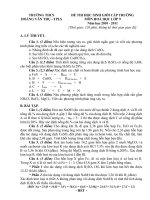trường thcs hoàng xuân hãn
Bạn đang xem bản rút gọn của tài liệu. Xem và tải ngay bản đầy đủ của tài liệu tại đây (34.43 KB, 3 trang )
<span class='text_page_counter'>(1)</span><div class='page_container' data-page=1>
<b>BRITISH COLUMBIA SECONDARY SCHOOL</b>
<b>MATHEMATICS CONTEST, 2015</b>
<b>Senior Final, Part A</b>
<b>Friday, May 1</b>
1. In the diagram, <i>ABCDE</i>is a regular pentagon, and<i>FAB</i>is
a straight line. Further, <i>FA</i>= <i>AB</i>. For the angles <i>x</i>,<i>y</i>, and
<i>z</i>the ratio<i>x</i>:<i>y</i>:<i>z</i>is:
(A) 1 : 2 : 3 (B) 2 : 2 : 3 (C) 2 : 3 : 4
(D) 3 : 4 : 5 (E) 3 : 4 : 6
A B
C
D
E
F
z
y
x
2. Recall that<i>n</i>! = <i>n×</i>(<i>n−</i>1)<i>×</i>(<i>n−</i>2)<i>× · · · ×</i>2<i>×</i>1. Only one of the expressions below is a perfect
square. It is:
(A) 23!<i>·</i>24!
3 (B)
24!<i>·</i>25!
3 (C)
25!<i>·</i>26!
3 (D)
26!<i>·</i>27!
3 (E)
27!<i>·</i>28!
3
3. Al and Bev play a game where they take turns removing 1, 2, 3, 4, or 5 coins from a pile which
origi-nally contains 2015 coins. The player who takes the last coin wins the game. If Al goes first, there is a
strategy that he can use that prevents Bev from winning. Using this strategy the number of coins he
should take on his first move in order to prevent Bev from winning is:
(A) 1 (B) 2 (C) 3 (D) 4 (E) 5
4. The six sides of a rectangular box have a total surface area of 175 square centimetres. The sum of the
lengths of all twelve edges of the box is 80 centimetres. The sum of the lengths, measured in
centime-tres, of the four interior diagonals of the box is:
(A) 16<i>√</i>5 (B) 20<i>√</i>7 (C) 60 (D) 75 (E) 30<i>√</i>3
5. A regular octagon has side length 6. Identical arcs with radius 3
are drawn with centre at each of the vertices of the octagon,
cre-ating circular sectors as shown. The region inside the octagon
but outside of any of the sectors is shaded. The area of the
shaded region is:
(A) 9
(
8+8<i>√</i>2<i>−</i>3<i>π</i>
)
(B) 9(16<i>−</i>3<i>π</i>) (C) 24(6<i>−π</i>)
(D) 8
(
9+9<i>√</i>2<i>−</i>3<i>π</i>
)
(E) 9
(
12+8<i>√</i>2<i>−</i>3<i>π</i>
)
6. The sum of the digits of the number 28531 is 19. If <i>N</i>is the smallest positive integer with a sum of
digits of 2015, the sum of the digits in<i>N</i>+1 is:
</div>
<span class='text_page_counter'>(2)</span><div class='page_container' data-page=2>
<b>BC Secondary School</b>
<b>Mathematics Contest</b> <b>Senior Final, Part A, 2015</b> <b>Page 2</b>
7. If <i>p</i>= 1 log<sub>10</sub>1+2 log<sub>10</sub>2+3 log<sub>10</sub>3+4 log<sub>10</sub>4+5 log<sub>10</sub>5+6 log<sub>10</sub>6, then the number 10<i>p</i>is an
inte-ger. The largest power of 2 that is a factor of 10<i>p</i>is:
(A) 212 (B) 214 (C) 216 (D) 218 (E) 220
8. The numbers 1, 2, 3, 4, and 5 are to be arranged in a circle. An arrangement is <i>good</i>if it is true that
for every<i>n</i>from 1 to 15 it is possible to find a subset of the numbers that appear consecutively on the
circle that sum to <i>n</i>. Otherwise the arrangement is<i>bad</i>. For example, the arrangement 1, 3, 5, 4, 2 is
good, since:
1=1, 2=2, 3=3, 4=4, 5=5, 6=4+2=2+1+3, 7=4+2+1
8=3+5, 9=5+4, 10=4+2+1+3, 11=5+4+2, 12=5+4+2+1
13=1+3+5+4, 14=3+5+4+2, 15=1+3+5+4+2
Arrangements that differ only by any combination of rotations or reflections are to be considered the
same. The number of different<i>bad</i>arrangements is:
(A) 1 (B) 2 (C) 3 (D) 4 (E) 5
9. In the 4<i>×</i>4 square shown, it is required to get from <i>X</i> to <i>Y</i>
moving along only the black lines. The total number of shortest
routes from<i>X</i>to<i>Y</i>is:
(A) 18 (B) 26 (C) 32
(D) 34 (E) 36
X
Y
</div>
<span class='text_page_counter'>(3)</span><div class='page_container' data-page=3>
<b>BRITISH COLUMBIA SECONDARY SCHOOL</b>
<b>MATHEMATICS CONTEST, 2015</b>
<b>Senior Final, Part B</b>
<b>Friday, May 1</b>
1. A helicopter flies north for some time at 80 km/hr, then flies 10 km east at 50 km/hr, and then flies
directly back to the starting point at 80 km/hr. If whole trip took one hour, how far north did the
helicopter fly during the first leg of the trip?
2. Hayden has a lock with a combination consisting of two 8s separated by eight digits, two 7s separated
by seven digits, two 6s separated by six digits, all the way down to two 1s separated by one digit. For
example, two 1s are separated by one digit in 121 . Unfortunately, Hayden spilled coffee on the
paper that the combination was written on, and all that can be read of the combination is:
5 8 4
Determine one of the two possible combinations of the lock.
3. Consider the 4<i>×</i>4 lattice shown. Determine the number of
rect-angles with horizontal and vertical sides that can be formed
us-ing four of the intersection points in the lattice as vertices. Note
that a square is a rectangle.
4. Inscribe a triangle with side lengths <i>a</i> <i>≤</i> <i>b</i> <i><</i> 2<i>r</i> inside
a semi-circle centred at <i>O</i> with radius <i>r</i>. On each of the
two shorter sides of the triangle construct two smaller
semi-circles with diameters of lengths<i>a</i>and<i>b</i>, respectively.
Prove that the sum of the areas of the two lunar regions,
shown shaded in the diagram, between the three
semi-circles equals the area of the triangle. b
a
r r
O
</div>
<!--links-->









